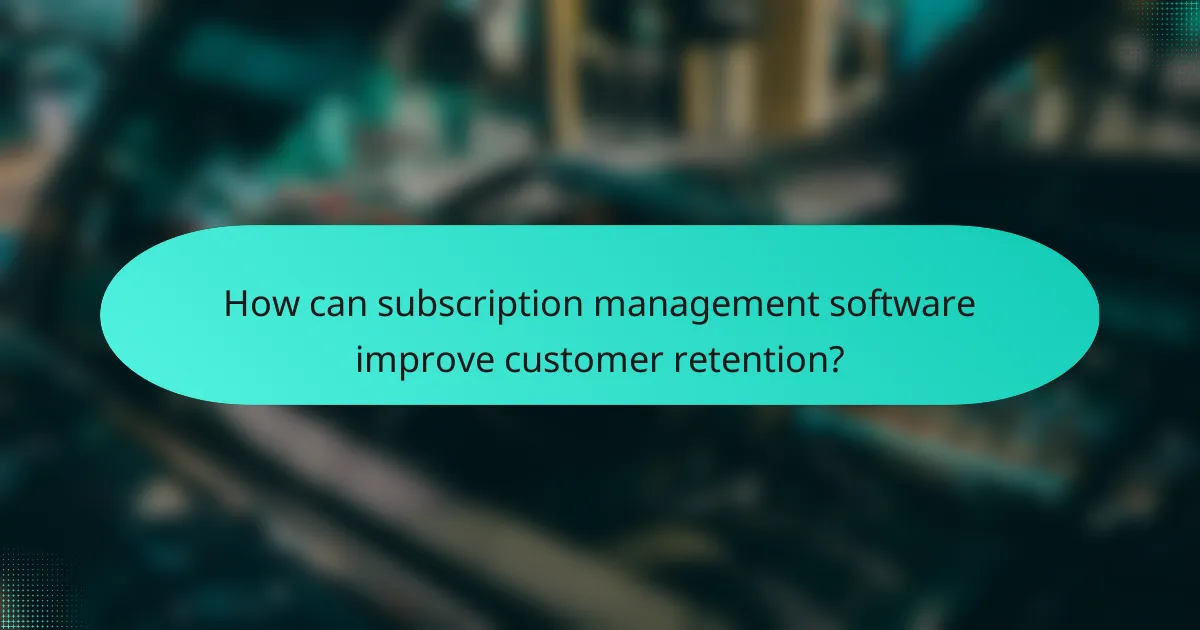Subscription management software is essential for businesses looking to streamline their billing processes and enhance customer retention. With features like customizable billing options, insightful analytics, and tools designed to improve customer loyalty, these solutions cater specifically to the needs of the Canadian market. By leveraging these capabilities, businesses can optimize their subscription models and gain valuable insights into their performance.

What are the best subscription management software options in Canada?
In Canada, several subscription management software options stand out for their features and usability. The best choices typically offer robust billing options, analytics, and customer retention tools tailored to meet the needs of businesses operating in the Canadian market.
Chargebee
Chargebee is a popular subscription management platform that provides comprehensive billing solutions and analytics. It supports various pricing models, including recurring billing, one-time charges, and usage-based billing, making it adaptable for different business needs.
With features like revenue recognition and automated invoicing, Chargebee helps businesses streamline their financial processes. Its analytics tools allow companies to track key metrics, such as churn rates and customer lifetime value, which are essential for improving retention strategies.
Recurly
Recurly offers a flexible subscription management solution that is particularly strong in billing automation and analytics. It provides features like dunning management and customizable billing cycles, which can enhance cash flow management.
Recurly’s analytics dashboard gives insights into subscription performance, helping businesses identify trends and optimize pricing strategies. It is suitable for companies of various sizes, from startups to large enterprises, looking to scale their subscription models effectively.
Zuora
Zuora is designed for larger businesses that require a robust subscription management system. It offers extensive billing capabilities, including complex pricing models and revenue recognition features that comply with accounting standards.
Zuora’s analytics tools enable businesses to gain deep insights into customer behavior and financial performance. This software is ideal for companies that need to manage a high volume of subscriptions and require detailed reporting for strategic decision-making.
Stripe Billing
Stripe Billing is part of the Stripe payment processing ecosystem and is known for its ease of integration and user-friendly interface. It supports various billing methods, including subscriptions, one-time payments, and metered billing.
With built-in analytics, Stripe Billing allows businesses to monitor subscription metrics and customer engagement. Its seamless integration with other Stripe services makes it a strong choice for businesses already using Stripe for payment processing.
PayPal Subscriptions
PayPal Subscriptions provides a straightforward way for businesses to manage recurring payments. It is particularly beneficial for small to medium-sized enterprises looking for a simple solution without extensive setup requirements.
While it may lack some advanced features found in other platforms, PayPal Subscriptions offers reliable billing and payment processing. Its familiarity and trust among consumers can enhance customer retention, especially for businesses targeting a Canadian audience.

How do billing options work in subscription management software?
Billing options in subscription management software allow businesses to automate and customize how they charge customers. These options can include various models such as recurring billing, one-time charges, usage-based billing, and trial periods, each designed to meet different customer needs and business strategies.
Recurring billing models
Recurring billing models are the backbone of subscription services, allowing businesses to charge customers at regular intervals, such as monthly or annually. This model ensures predictable revenue streams and simplifies cash flow management.
Common variations include fixed-rate subscriptions, where customers pay a set fee, and tiered pricing, where costs vary based on usage levels or features. Businesses should consider offering discounts for longer commitments to encourage customer retention.
One-time charges
One-time charges are fees that customers pay for a specific service or product, rather than on a recurring basis. This option is useful for businesses that offer add-ons or premium features that customers may want to purchase occasionally.
Examples include setup fees, upgrades, or special event access. It’s important to clearly communicate these charges to customers to avoid confusion and ensure transparency in billing practices.
Usage-based billing
Usage-based billing allows customers to pay according to their actual usage of a service, making it a flexible option for both businesses and consumers. This model is common in industries like telecommunications and cloud services.
Businesses should track usage accurately and provide clear reporting to customers. Setting thresholds for usage can help manage costs and prevent unexpected charges, which can enhance customer satisfaction.
Trial periods
Trial periods offer potential customers a chance to use a service for free or at a reduced rate for a limited time. This approach can significantly boost customer acquisition by allowing users to experience the value of a product before committing financially.
It’s essential to define the trial duration clearly and communicate any conditions, such as automatic billing after the trial ends. Monitoring conversion rates from trials to paid subscriptions can help refine marketing strategies and improve customer retention.

What analytics features should you look for?
When selecting subscription management software, prioritize analytics features that provide insights into customer behavior, revenue trends, and overall business health. Key analytics capabilities include customer lifetime value tracking, churn rate analysis, revenue forecasting, and subscription growth metrics.
Customer lifetime value tracking
Customer lifetime value (CLV) tracking measures the total revenue a business can expect from a single customer over their entire relationship. This metric helps businesses understand the long-term value of acquiring and retaining customers. A typical CLV calculation considers average purchase value, purchase frequency, and customer lifespan.
To effectively track CLV, utilize software that integrates sales data and customer interactions. This allows for more accurate forecasting and targeted marketing efforts aimed at high-value customers.
Churn rate analysis
Churn rate analysis quantifies the percentage of subscribers who cancel their subscriptions within a given period. Understanding churn is crucial for identifying retention issues and improving customer satisfaction. A typical churn rate for subscription services can range from 5% to 10% monthly, depending on the industry.
To analyze churn effectively, segment customers by demographics or subscription plans. This helps pinpoint specific areas where improvements can be made, such as enhancing customer support or adjusting pricing strategies.
Revenue forecasting
Revenue forecasting predicts future income based on historical data and market trends. This feature is essential for budgeting and strategic planning. Reliable forecasting can help businesses anticipate cash flow needs and make informed decisions about investments or expansions.
Employ software that uses predictive analytics to generate forecasts. Consider factors like seasonal trends, customer acquisition costs, and economic conditions to create more accurate projections.
Subscription growth metrics
Subscription growth metrics track the increase or decrease in subscribers over time. These metrics provide insights into the effectiveness of marketing strategies and overall business health. Key indicators include new subscriber acquisition rates, renewal rates, and upsell conversions.
To monitor growth effectively, set up dashboards that visualize trends over time. This allows for quick adjustments to marketing campaigns and helps identify successful strategies for attracting and retaining subscribers.

How can subscription management software improve customer retention?
Subscription management software enhances customer retention by providing tools that facilitate personalized communication, automate churn prevention, and integrate loyalty programs. These features help businesses engage customers effectively, reduce cancellations, and foster long-term loyalty.
Personalized communication tools
Personalized communication tools enable businesses to tailor messages and offers based on customer behavior and preferences. By analyzing user data, companies can send targeted emails, notifications, or promotions that resonate with individual subscribers, increasing engagement and satisfaction.
For example, a streaming service might recommend shows based on a user’s viewing history, encouraging them to stay subscribed. Implementing segmentation strategies can help ensure that communications are relevant, which is crucial for maintaining customer interest.
Automated churn prevention strategies
Automated churn prevention strategies involve using data analytics to identify at-risk customers and proactively addressing their concerns. Subscription management software can track usage patterns and flag accounts that show signs of disengagement, allowing businesses to intervene before a cancellation occurs.
Common strategies include sending reminders about unused features, offering discounts, or providing personalized support. For instance, a software-as-a-service (SaaS) company might reach out to users who haven’t logged in for a while with a special offer to reignite their interest.
Loyalty programs integration
Integrating loyalty programs into subscription management software can significantly enhance customer retention by rewarding subscribers for their continued patronage. These programs can offer points, discounts, or exclusive content, incentivizing customers to remain loyal to the brand.
For example, a subscription box service might provide points for every month a customer stays subscribed, which can be redeemed for free products or discounts. Ensuring that loyalty rewards are easily accessible and valuable can increase customer satisfaction and reduce churn rates.
